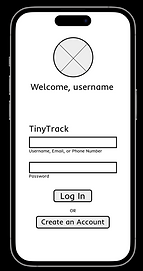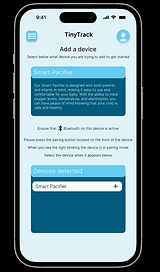Hi, I'm Srinivas Kotha, a UX Designer.
TinyTrack
TinyTrack is a parenting app that can help parents multitask with their duties and responsibilities to their children and their homes. Parents can take care of their child’s health remotely and check on them whenever it is possible. With TinyTrack, this will ease the stress on parents by having advanced technologies guide them.

Overview
Our vision for the future of childcare is to create a technologically
advanced, convenient, and secure environment that benefits both parents and children, using AI and sensor-based technologies to provide data tracking, predictive software, and vital monitoring to ensure the well- being of children.
Problem
Parents are facing significant challenges in regards to childcare today, with high costs, a shortage of providers, and a lack of flexibility being primary concerns. However, IoT technology has the potential to revolutionize the childcare industry by providing real-time monitoring, automated administrative tasks, and remote access to educational resources. By leveraging IoT devices, parents can better balance their work and family responsibilities, while ensuring their children's safety and learning needs are met.
Goals
With childcare IoT, users(parents) can do the following:
Get notified about child’s health conveniently
Observe their child’s behavior remotely
Control devices that a child interacts with everyday
User Research
Team
This project was conducted by 4 members including me. I was in charge of designing the following wireframe mockups: Smart Pacifier that records the body temperature and estimated oxygen variation
Tools
created low fidelity wireframes and high-fidelity prototype in Figma
Timeline
Jan 2023 - May 2023
Using the 5-step Design Thinking Process, which includes empathizing with users, defining the project’s objective, ideating, prototyping, and testing the prototype to receive feedback, we designed an app which will ease up the stress away from the parents by interacting with the app, and eventually, learn to balance childcare responsibilities with other daily activities. We have conducted Market Research and Binocular Research using AEIOU's: Activities, Environment, Interactions, Objects, Users.
According to International Conference on Electronics and Sustainable Communication Systems (ICESC) “Child care has become a significant challenge with the emerging modern work culture, where both men and women are ever occupied with their work schedules. On the other hand, digital technologies are revolutionizing our day-to-day activities and this technological advancement can also play a significant role in the field of child care… The proposed Internet of Things (IoT) based child monitoring system is a well-organized low-cost system for monitoring the child in real-time. It allows parents to easily monitor their children by continuously tracking their activities.”

Activities:
- Make child care easier (educational): new ways to teach with online resources, computer software specifically designed for children
- Increase safety: Managing content children will get to consume, Managing security systems with at home consumer products
- Convenience: New innovations in IOT incorporation with everyday products: smart pacifiers, toys, etc.
Environment:
- At home: online learning and games, software to limit time of use, baby monitors
- In School: online learning and games, communication with parents, security, record keeping
Interactions:
Why Interaction is Important? Why do we need childcare service to help that?
- Social interaction is very important for children as it has a lifelong effect as they grow to become an adult.
- Childcare will help with teamwork as people need to collaborate and communicate together to meet a final goal. When children play together, they will develop tactics to work well with others.
- Social interaction can help with communication and can help children help identify them as individuals. With Nonverbal communication, they will understand emotions and express themselves.
- Social interactions build friendships, building confidence and self-esteem.
- Technology should be used wisely. It can help children grow, explore new worlds, engage in fun activities, play, and solve problems
Positives
-Organization: planning, online calendars to stay updated, group text messaging to keep up with each other.
-Self-expression: people can share their thoughts online through social media, connect with others, and build self esteem.
-Creativity: children can explore various interests
Negatives
-Advancement of technology makes parenting children hard
-Social Skills: lead to more socially awkward, shy, hard to engage with others,
-Relationships: Children are used to being alone instead of socializing with their parents, friends , etc.
-Ability to focus: short attention span due to reliance in technology
Objects:
- smart wearable breast pumps – hands-free, “stealth” breast-cups
- smart dispensers – syringes for medicine dispense into the mouth
- smart pacifiers – with temperature check-ups and GPS tracker
- stationary baby room monitors – with cameras, microphones, and speakers
- smart bassinets – cribs that rock, shush, and stabilize the baby
- wearable monitors, trackers – to track the baby’s positions
- wearable heart rate and oxygen monitors – if recommended by the doctor
Users:
- The primary users would be parents and children
- A parent’s first instinct is to protect and care for their child in any way that is necessary.
- A child naturally depends on their parents for care.
- The parent–child interactions provide the primary social learning context from infancy.
- Daycare, child care facilities

One of my family members works full-time and has a baby who is 2-years-old.
- Juggling a demanding full-time job with the responsibilities of motherhood can be overwhelming for her. Often finds herself torn between work commitments and wanting to be present for important milestones in
- finding reliable childcare arrangements that align with her work schedule can be a logistical challenge.
- tech-savvy, reads a lot and enjoys incorporating smart devices into her daily life to simplify tasks and stay organized.
- relies heavily on her smartphone and various productivity apps to manage her schedule, communicate, and responsibilities.
Different IOT Apps
Features
Smart pacifiers:
- Babies use pacifiers starting from birth and stop using them until they become 2-4 years old. With Machine Learning Algorithms which act like humans, this makes IOT devices smarter.
- Now with Smart Pacifiers, parents can check whether the baby has a fever, the location of the child, and share this information with their relatives and doctors.
- For example, when your baby is crying late in the night, you can pacify the baby and check their temperature at the same time.
Smart Bassinet:
- Smart bassinets are very useful because as the baby cries, it will make sure the baby is quiet and if the baby is not sleeping, it will rock the baby in case the parent is in another room.
- Baby monitors are placed on the table near the bassinet or attached to the wall.
- It has night vision, movement sensors, and checks room temperature to see the baby at night, to report when the baby is active at night, and to see if the temperature would affect the baby.
Smart Thermometer:
- Smart thermometers can add a lot of data to the IOT with tracking illness
- Through software and application it tracks down to the zip code where people are experiencing fever symptoms
Lo-Fi Wireframes







Designing
The name, TinyTrack came from the desire to empower parents with a simple yet powerful tool to monitor their child's health and well-being.
It's more than just an app; it's a symbol of love, dedication, and peace of mind for parents everywhere.
Font

App Logo

Color

We decided to go with light blue because according to LinkedIn, it is associated with positive feelings, loyalty, trust, and peace. The Inter font (Sans-serif font) is also known for being neat-looking, clean , minimalistic, and highly legible.
Reflection
Our vision for the future of childcare was to create a technologically advanced, convenient, and secure environment that benefits both parents and children, using AI and sensor-based technologies to provide data tracking, predictive software, and vital monitoring to ensure the well-being of children.
Integrating AI and sensor-based technologies into childcare solutions enables real-time monitoring of vital health metrics such as temperature, sleep patterns, and activity levels. This innovation not only enhances the caregiving experience but also gives a deeper sense of confidence and peace of mind for parents while promoting the well-being of children. We also wanted to make sure the parent gets notified about the child's health no matter where they are. That way, this convenience not only reduces stress and uncertainty, but also enables parents to focus more on bonding with their children rather than worrying about their health.
In the future, we plan on adding more features, updates, and conduct usability tests by gathering feedback from parents and caregivers through surveys, interviews, and observational studies.








